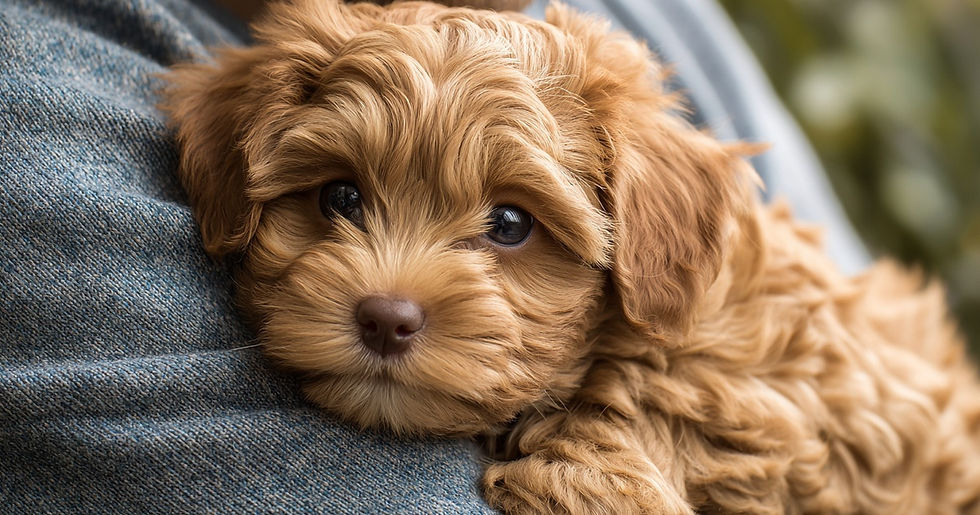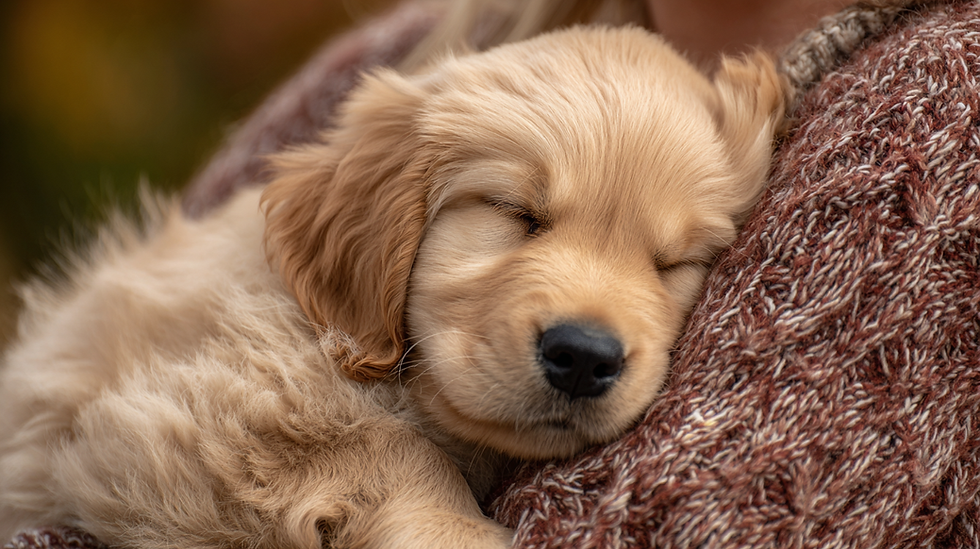Puppy Sleep Schedules: How Much Sleep Is Normal and How to Encourage It
- nannykp76
- Oct 7
- 4 min read

Sleep is one of the most powerful tools for raising a healthy, happy puppy. In those first months of life, their brain is constantly forming new connections, their body is changing almost daily, and they are learning how to navigate a brand-new world. All of that takes energy and a lot of it.
Adequate rest is not just "nice to have". It supports immune health, fuels physical growth, builds memory, strengthens learning, and keeps emotions balanced. Without enough rest, a puppy's developing nervous system can easily become overstimulated. When that happens, you might see hyperactivity, wild zoomies, intense biting, barking, or sudden meltdowns. These aren't signs of a "bad" puppy. They're signs of a tired puppy who needs help winding down.
Knowing how much sleep is normal, and how to shape your home routine so rest is easy and predictable, will make daily life calmer for everyone and set your puppy up for success well into adulthood.
How Much Sleep Do Puppies Need?
Most young puppies need 18 to 20 hours of sleep every 24 hours. This includes their overnight sleep plus several naps spread throughout the day. Even when your puppy seems energetic between naps, remember that under the surface, growth and learning are happening at high speed. Rest is what allows all that development to stick.
Older puppies still need a lot of rest. They usually need 16 to 20 hours depending on their breed, age, and energy level. Here;s a quick guide:
8-12 weeks old: 18-20 hours per day
3-6 months old: 16-18 hours per day
6-12 months old: 14-16 hours per day
Over 1 year: Most dogs do well with 12-14 hours, though large and giant breeds often sleep more
If your puppy seems to sleep more than this but is otherwise healthy and energetic when awake, that can be perfectly normal, especially in breeds bred for calmer, lower-stamina work.
A Sample Daily Sleep Rhythm
While you don't need to enforce a rigid schedule, most puppies thrive with predictable patterns. A balanced day might look like this:
Morning: Wake, potty, breakfast, short walk or gentle play → nap
Mid-morning: Wake, potty, light training or puzzle toy → nap
Midday: Wake, potty, lunch (if on 3 meals), brief play → nap
Afternoon: Wake, potty, socialization or short outing → nap
Evening: Wake, potty, dinner, short walk or play → wind-down time
Night: Last potty break, bedtime routine, overnight sleep (with 1 potty break if under 12 weeks)
Each nap can last anywhere from 30 minutes to 2 hours depending on your puppy's age and environment. The key is not keeping them awake too long in the hope they will "wear out". This thinking will typically backfire, leading to cranky, overstimulated behavior.
How to Encourage Healthy Sleep
Creating the right environment is just as important as tracking hours. Puppies need to feel physically safe and emotionally secure before they can truly relax.
Set a consistent sleep space - whether it's a crate, pen, or small puppy-proofed room. Use the same area for most naps and bedtime so it feels familiar and comforting.
Keep the environment calm - dim lights, use a white noise machine or gentle background music, and limit foot traffic nearby.
Use a wind-down routine - a short potty break, gentle petting, or a few minutes with a safe chew can signal that it's time to rest.
Avoid over-tiredness - zoomies, nipping, and barking bursts are often signs your puppy is overdue for a nap.
Offer calming activities - licking mats, safe chew toys, or slow sniff games help shift energy down before rest.
Manage interruptions - well-meaning visitors and sudden noises can break a puppy's natural rhythm. Communicate with family and friends so your puppy's sleep is protected.
Recognizing Sleep Cues
Not every puppy simply curls up and nods off when tired. In fact, many act more wound-up the sleepier they get. Look for early signs:
Yawning or slow blinks
Stretching and then lying down briefly
Wandering away from play toward a quiet spot
Burrowing into blankets or under furniture
Glassy, unfocused eyes
Sudden increase in rough biting or barking
When you spot these cues, guide your puppy toward their sleep space. The earlier you catch tiredness, the easier the transition to rest will be.
If Your Puppy Struggles to Nap
Some puppies, especially in busy households, try to power through the day. They end up crashing hard at night but remain overtired and edgy during waking hours. To break this cycle:
Offer rest opportunities after meals and active play, even if they don't seem sleepy yet
Use a crate or pen with light covering to block visual distractions
Play calming music or use a white noise machine
Pair nap time with a safe chew to encourage settling
Avoid using the crate as punishment because you want it to always feel safe
Keep your daily rhythm predictable so their internal clock learns when to expect rest


Comments